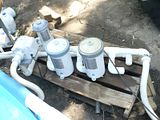There may be some of us that see the potential available with a cheap pool. One of my projects this summer with mine is to modify the cartridge filter system to increase the available filter area by combining several similar sized pumps.
Take a couple dead pump/filter sets apart, and hard plumb the canisters together in parallel to a working pump unit. Having had an Intex pump apart, the motor itself appears to be a somewhat robust open frame 1/2 hp unit, electrically isolated from the impeller section. Not a bad deal, at least for the 56633EG 2500gph unit. I don't know about the higher output sand filter sets, but I may get into that at a later date.
Theory about the sometimes lack of longevity of these cart type Intex pumps: With such a relatively small filter surface area, the pump itself may be oversized (think AG pool builder routine -- bigger is better!) for the filter size. High flow rate and pressure through 15 sq ft of filter, means fines can and do get forced through the sometimes poor filter media. This can be helped to a point by buying better filters, I.E. Unicel or Filbur. In my case, the 633 set needs Unicel 5315, or Filbur 3752. As the relatively small filter gets full, the load on the motor increases, heating the motor to the point of "killing" it. With no gauge, you can't know just how dirty your filter is getting.
The idea is to parallel several canisters off of one pump to do two things.
First, decrease the flow rate through each filter. If my theory is even half correct, that should make a difference on what the pump sees as back pressure, reducing the load on it. From experience in other fields, a moderately loaded 1/2 hp motor will last quite a bit longer than a similar motor being run at max load all the time.
Second, increase the filter square footage. The advantages here would be better filtration and the ability to capture more of the fines through reduced flow through each filter. This would also go a long way towards increasing the time between filter changes and/or replacement.
Another couple of advantages with this would be to have the ability to install a gauge between the pump and filters, and a possible "vacuum to waste" valve. I don't think a "backwash" set-up would be a good idea with carts, since I know of no commercially made cart system that incorporates this.
I put this out there for anyone skilled in pool pump technology to confirm, refute, or improve on my idea.
Take a couple dead pump/filter sets apart, and hard plumb the canisters together in parallel to a working pump unit. Having had an Intex pump apart, the motor itself appears to be a somewhat robust open frame 1/2 hp unit, electrically isolated from the impeller section. Not a bad deal, at least for the 56633EG 2500gph unit. I don't know about the higher output sand filter sets, but I may get into that at a later date.
Theory about the sometimes lack of longevity of these cart type Intex pumps: With such a relatively small filter surface area, the pump itself may be oversized (think AG pool builder routine -- bigger is better!) for the filter size. High flow rate and pressure through 15 sq ft of filter, means fines can and do get forced through the sometimes poor filter media. This can be helped to a point by buying better filters, I.E. Unicel or Filbur. In my case, the 633 set needs Unicel 5315, or Filbur 3752. As the relatively small filter gets full, the load on the motor increases, heating the motor to the point of "killing" it. With no gauge, you can't know just how dirty your filter is getting.
The idea is to parallel several canisters off of one pump to do two things.
First, decrease the flow rate through each filter. If my theory is even half correct, that should make a difference on what the pump sees as back pressure, reducing the load on it. From experience in other fields, a moderately loaded 1/2 hp motor will last quite a bit longer than a similar motor being run at max load all the time.
Second, increase the filter square footage. The advantages here would be better filtration and the ability to capture more of the fines through reduced flow through each filter. This would also go a long way towards increasing the time between filter changes and/or replacement.
Another couple of advantages with this would be to have the ability to install a gauge between the pump and filters, and a possible "vacuum to waste" valve. I don't think a "backwash" set-up would be a good idea with carts, since I know of no commercially made cart system that incorporates this.
I put this out there for anyone skilled in pool pump technology to confirm, refute, or improve on my idea.


